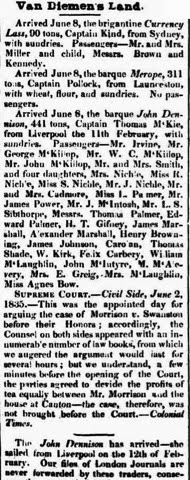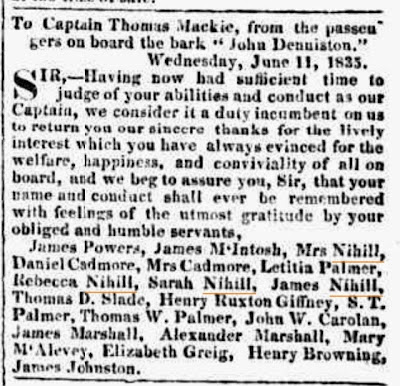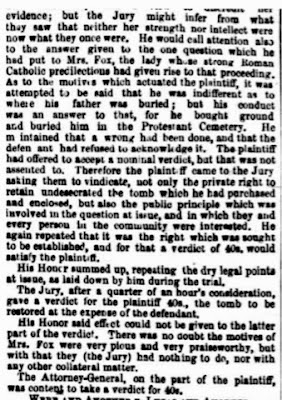My third great grandmother Mary Cudmore née Nihill (1811 – 1893) was born near Adare, County Limerick, Ireland, to Daniel James Nihill (1761 – 1846) and Dymphna Nihill née Gardiner (1790 – 1866). Mary was the oldest of their eight children, seven of whom were girls.

Mary Cudmore née Nihill probably photographed in the 1850s
For some period, Mary’s father Daniel James Nihill, was employed as a schoolmaster at Cahirclough (Caherclogh), Upper Connello, about ten miles south of Adare. Daniel’s father James owned a large stone farmhouse near Adare called ‘Rockville’. Daniel and his family lived with James Nihill and cared for him until his death in 1835. The house and its associated estate, Barnalicka, were then passed to the daughters of Daniel’s older brother Patrick Nihill (died 1822).
[Rockville House, now known as Barnalick House, operates as bed-and-breakfast tourist accommodation.]

On 15 January 1835 Mary married Daniel Michael Paul Cudmore who was from a village near Cahirclough, called Manister.
The Limerick Chronicle of 24 January 1835 reported the marriage:
At Drehedtarsna Church, in this County, by the Rev. S. Lennard, Daniel Cudmore, Esq. son of the late Patrick Cudmore, of Manister, Esq. to Mary, eldest daughter of Daniel Nihill, of Rockville, near Adare, Esq.
The Cudmores were poorer than the Nihills. Daniel’s parents had separated and his father had died in 1827 . About 1822 their mother, a Quaker, sent Daniel and his older brother Milo to be educated by fellow Quakers in Essex, England. In 1830, when Milo finished his apprenticeship to a baker and flour dealer, Daniel and Milo returned to Ireland.
Daniel seems not to have trained for a trade, but his mother found a position for him with John Abell, a family friend, who ran a hardware store in Rutland Street, Limerick. There he gained a working knowledge of the hardware business, which perhaps proved useful to him in his later career.
In January 1834 Daniel Cudmore sought permission to emigrate as an assisted immigrant to New South Wales, proposing that he would undertake to ‘explore the interior of New Holland’. His application was turned down. A newspaper notice in the Freemans’ Journal of 15 April 1834 made it clear that assisted emigration was available only to young and married agricultural labourers who intended to take their wives and families with them.
Daniel had known Mary Nihill for a some time. In 1833 he wrote a poem to her:
To Mis N—-l
Dear Mary, since thy beaming eye
First raised within my heart a sigh –
Since first thy tender accents clear,
More sweet than music, charm’d my ear,
My heart beat but for thee, love.
This heart which once so blythe and gay,
Ne’er owned before Love’s gentle sway,
Now bound by Cupid’s magic spell!
O! Words would fail were I to tell
The half I felt for thee, love.
Though far from Erin’s vales I stray’d,
I never met so fond a maid;
Though England’s fair ones vaunt their gold,
With all their wealth their hearts are cold –
I leave them all for thee, love.
And should Australia be my lot,
To dwell in some secluded spot,
Content and free from want and care,
Would’st then my humble fortune share? –
My hopes all rest on thee, love!
The handwritten original is in the possession of one of my cousins. It appears that ‘Australia’ in the last verse was added well after its composition. This suggests that Daniel had decided to emigrate but had not yet decided where.
In 1835, as Mary’s grandfather James Nihill approached the end of his life, Daniel Nihill, perhaps recognising that he could have no expectations, and with little to keep him in Ireland, decided to emigrate to Australia. By their marriage, Mary and Daniel Cudmore qualified for assistance. On 11 February 1835 they left on the “John Denniston” for Hobart Town. Mary’s mother and two of her sisters travelled with them.
Six months later, after the death of Daniel’s father James in July, Daniel Nihill and Mary’s other sisters followed.
On his arrival in Hobart Daniel Cudmore applied for a teaching position. However, a review of his application found that it was not written by himself. Mary had written the document on his behalf. Nevertheless, such was the shortage of trained people, Daniel was engaged as a teacher and clerk at Ross, in the Midlands, seventy miles north of Hobart.
On 22 July 1836 Mary gave birth to her first child, a daughter called Dymphna Maria, at George Town, where Mary’s parents were teachers. George Town was a small settlement on the Tamar River thirty miles north of Launceston.
By the end of 1836, however, Daniel had moved back to Hobart, where he found work at De Graves Brewery, later to be known as Cascade Brewery.
A year later Daniel and Mary decided to try their luck in Adelaide, which had been proclaimed a colony on 28 December 1836. Daniel arrived on 15 April 1837. Mary, leaving her 14 month old daughter in the care of her mother, travelled on the “Siren” from Launceston to Adelaide with her father and sister Rebekah. Mary was pregnant, and on 11 October 1837 gave birth prematurely to a son, James Francis, on the “Siren” off Kangaroo Island.
On 3 December 1837 visitors from England, who were friends of Daniel’s mother Jane, called on the Cudmores. They wrote:
… at a hut we saw an elderly man sitting at the door, reading, we found it was the dwelling of Daniel Cudmore, son of Jane Cudmore of Ireland…and the old man was his father-in-law. D. Cudmore has greatly improved his prospects temporally by removing from Tasmania, where he was an assistant in the undesirable business of a brewer; he is here occupied in erecting Terra Pisa buildings and both himself and his wife are much respected.

Daniel Michael Paul Cudmore and his wife Mary probably taken in the 1850s
Daniel acquired his first block of land in North Adelaide in December 1837. By 1838 he was a partner in a new brewing company. Daniel farmed at Modbury, ten miles north-east of the main Adelaide settlement. In 1847 he inherited property in Ireland. This he sold to take up a pastoral lease in South Australia. In the 1850s and 1860s he acquired more pastoral leases in Queensland and New South Wales. Mary Cudmore appears to have had an active involvement in the management of the Cudmore properties. In 1868, for example, it was she who gave the instructions for the sale of a farm called Yongalain 1868.
Beside the two children mentioned above Mary Cudmore had 7 more:
- Mary Jane Cudmore 1839–1912
- Margaret Alice Cudmore 1842–1871
- Daniel Henry Cashel Cudmore 1844–1913
- Sara Elizabeth (Rosy) Cudmore 1846–1930
- Robert Cudmore 1848–1849
- Milo Robert Cudmore 1852–1913
- Arthur Frederick Cudmore 1854–1919
In 1862 Daniel Cudmore bought and extended a villa in the Adelaide Hills
at Claremont, Glen Osmond, five miles south-east of the city. There he
retired with Mary. Daniel died in 1891, she in 1893. They were buried in
the Anglican cemetery at Mitcham. In his retirement he had published a
volume of poetry, including the poem he wrote to Mary in 1833.

Claremont, Glen Osmond

Grave of Daniel and Mary Cudmore Mitcham (St Michaels Anglican) Cemetery

Grave of Daniel and Mary Cudmore Mitcham (St Michaels Anglican) Cemetery
The theme of this week’s post is ‘prosperity’. It is pleasing to suppose that beside Daniel and Mary’s material success, they prospered as a couple, joined together, through richer and poorer, for fifty-six years.
Related posts
Sources
- In the 1990s James Kenneth Cudmore (1926 – 2013), my second cousin once removed, of Quirindi New South Wales, commissioned Elsie Ritchie to write the Cudmore family history. The work built on the family history efforts of many family members. It was published in 2000. It is a very large and comprehensive work and includes many Cudmore family stories and transcripts of letters and documents. (Ritchie, Elsie B. (Elsie Barbara) For the love of the land: the history of the Cudmore family. E. Ritchie, [Ermington, N.S.W.], 2000.)
- P. A. Howell, ‘Cudmore, Daniel Michael (1811–1891)’, Australian Dictionary of Biography, National Centre of Biography, Australian National University, http://adb.anu.edu.au/biography/cudmore-daniel-michael-6335/text9913, published first in hardcopy 1981
- Gunton, Eric Gracious homes of colonial Adelaide (1st ed). E. Gunton, [Adelaide], 1983.
Further reading
- Cudmore, Daniel. A few poetical scraps : from the portfolio of an Australian pioneer : who arrived at Adelaide in the year 1837 Printed by Walker, May &Co Melbourne 1882










































